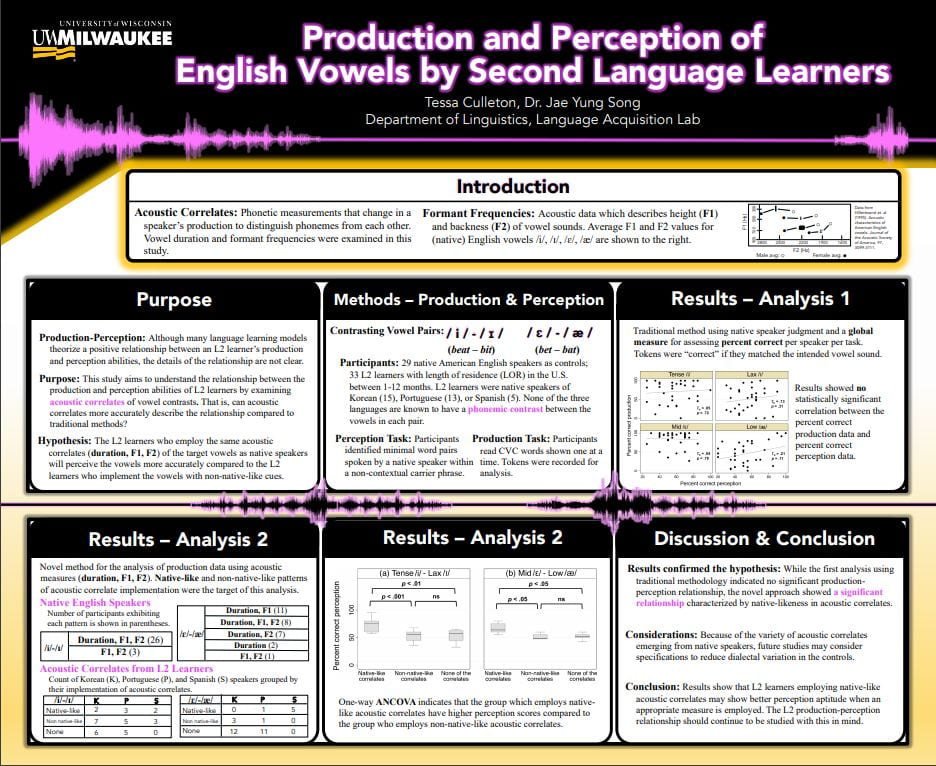Tessa Culleton, “Production and Perception of English Vowels by Second Language Learners”
Mentor: Jae Yung Song, Linguistics
Many language learning models imply a relationship between second language (L2) learners’ production and perception abilities. However, prior studies of the perception-production relationship have relied primarily on transcriptions and native English speaker judgments in assessments of production accuracy; they have not often utilized acoustic measurements such as vowel duration and formant frequencies. This study aims to understand the production and perception relationship through a novel acoustic measure of L2 production. The study focuses on the perceptual and produced distinction between two vowel pairs: /i/-/ɪ/ (as in beat-bit) and /ɛ/-/æ/ (as in bet-bat). The participants were 29 native-speakers of American English, serving as controls, and 33 L2 learners of English from three native-language backgrounds: Korean, Portuguese, and Spanish. Speakers were asked to identify words produced by native English speakers for the perception task, and produce words shown to them for the production task. The analyses performed allowed for a comparison of the traditional methodology, using native judgments, and the novel methodology, using acoustic data. The novel approach implemented an analysis of acoustic correlates employed by native speakers to distinguish the contrasting vowel sounds. For those L2 learners who employed the same acoustic correlates in their production of the vowel pairs, there was found to be a significant correlation between the speakers’ production and perception accuracy compared to those who did not employ the native-like acoustic correlates. The study provides compelling evidence that production and perception is a bi-directional relationship. By comparing these findings to the traditional approach for researching the perception-production relationship, the study contributes a novel approach to studying L2 acquisition.
Click the thumbnail below to open the full sized poster in a new tab.

This is fascinating. I would never have thought of this for 2nd language learners. Or for someone like myself who may try and learn a second language. This also makes sense as to why reading would be easier than speaking a second language. Well done!
Carla, thank you for your comments. The literature on the production-perception relationship is so varied within L2 teaching/learning models that the novel approach of this study brings in another perspective with which to begin analyzing this relationship. Much of the previous analysis and literature of this question centers on native judgments on L2 perception (listening) and production (speech), whereas this analysis (Analysis 2 in the presentation) involves objective measurements (duration, formant frequencies) as compared to native controls. These measurements are commonly attested in phonetics research and indicate a fine-grained acoustic analysis can be powerful to add to this field of research. Implications, as you mention, regard the efficacy of particular L2 teaching/learning models in which production and perception are learned in concert.
Hello! I am Tessa Culleton, undergrad in Linguistics at UWM. I have been working remotely with Dr. Song for the last two semesters for the Language Acquisition Lab. I am very excited about the implications of this project, and excited to share and discuss these outcomes. Thank you for your time.
Well-done, Tessa and Jae Yung!
I have one question. What were the criteria for your decision on using specific acoustic correlates for phonemic contrasts? Did you use the same criteria for native speakers and non-native speakers?
Hi Dr. Park! Thank you.
From my understanding, previous research by Flege et al. (1997), which was a significant forebear of this study, showed that native controls (speakers of American English) showed temporal and spectral differences in distinguishing the vowel pairs in question in this study. Flege et al. concluded that L2 learners were more likely to employ spectral cues correlating to their experience level. So the study uses this background for some confidence that spectral and temporal cues are reasonable criteria for assessing the phonemic contrasts in these vowel pairs for both native and non-native speakers.
I will turn your attention to the bottom left box on the poster to show what acoustic correlates were employed by the native speakers within this study. These correlates were then called “native-like” and those non-native speakers who employed these patterns and only these patterns to create phonemic contrast were grouped under “native-like.”
One interesting ongoing question is that of the control data variation in acoustic correlates in the /ɛ/-/æ/ pair. Like Peterson & Barney (1952) and Hillenbrand et al. (1995) each show different spectral data in comparing these vowels, a difference is showcased by the variety of spectral correlates applied even by native speakers to achieve a contrast.
I hope this rather lengthy response answers your question.
This is a clear presentation of an interesting topic for many in our department. Well done, Tessa! It was nice to have both a voice over walk through presentation available with your poster. This is a great introduction to your research without it being overwhelming for audience members without a background in phonetics. I also like the overall presentation of your poster. It is very reader-friendly and a well organized presentation of your data.
After completing this study, what are some areas where you could apply your findings for further research? In other words, what’s the next step now that you’ve found your novel approach to be significant?
Also, do you think there are pedagogical applications for your findings and if so, do you think they would be accessible to language instructors without a strong background in acoustic phonetics?